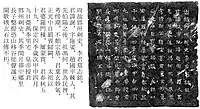Tomb of Li Dan
The Tomb of Li Dan (Chinese: 李诞墓; pinyin: Lĭ Dàn mù), is a Northern Zhou period (557-581 CE) funeral monument to a foreigner named "Lĭ Dàn" (李诞) in the Chinese epitaph. The tomb was excavated in the east of the ancient city of Xi'an, capital of the Western Wei (534-557 CE) and Northern Zhou (557-581 CE) dynasties, in the same area where the tombs of Kangye, Anjia and Shijun were discovered. The tomb with its epitaph are now located in the collections of the Xi'an City Museum. Lĭ Dàn died in 564 CE.[1]
| Tomb of Li Dan | |
|---|---|
.jpg.webp) Tomb of Li Dan, Xi'an City Museum. | |
| Created | 564 CE |
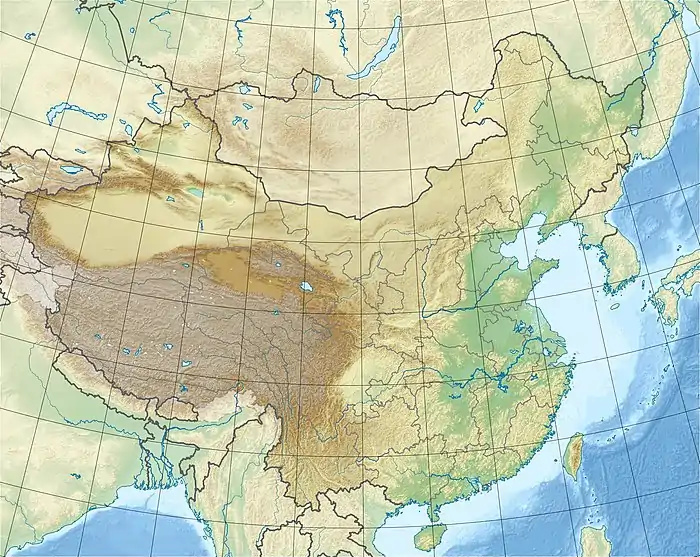 Xi'an | |
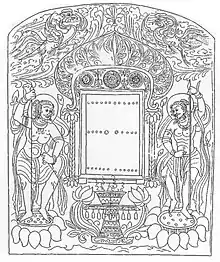
Epitaph
According to the epitaph, Lĭ Dàn was a "Brahmin" (Chinese: 婆罗门 Póluómén).[1] He descended from an honourable family, and his grandfather had once been a tribal leader. Between 520 and 525 CE, he and his family migrated from Jibin (area of Gandhara in northwestern India) to China, and received the favours of Emperor Taizu (507–556 CE).[1] Lĭ Dàn died at the age of 59 in his home in Xi'an, in 564 CE. He received posthumously the title of "Prefect of the Hán Prefecture" ("邯州刺史") from the Emperor. His son Panti (槃提) wrote the epitaph.[1]
The epitaph reads:
Epitaph of Li Dan"Epitaph of Li Dan, also named Li Tuosuo, deceased Prefect of the Province of Han, who lived in Pingji, Zhao country, descendant of Bo Yang. His grandfather was Feng He, a tribal ruler, who worked hard and maintained the standing of his lineage. The deceased was a honorable man, who traveled from Jibin to the Imperial court during the Zhengguang era (520–525 CE). Because he was a Brahmin, Emperor Taizong offered him plenty of gifts and rewards. The deceased died at the age of 59, on April 9th, in the 4th year of the Baoding era (564 CE), year of the Wood Monkey, at his home in Wanjili. The Emperor gave him the title of "Prefect of the Province of Han", and he was buried in the leap month of that same year in Zhonxiangli. His elder son Panti, fearing cataclisms, and afraid the name of his father might be forgotten, reverently wrote this inscription on a black stone, so that his story can be transmitted unblemished."
— Epitaph of Li Dan, written by his son Panti in 564 CE.[2]
Tomb
The tomb was a single arc-square brick chambered tomb, with a long sloping passage and tunnel, reflective of traditional Chinese tombs of the Northern Zhou period.[1] Enclosed by a brick wall, it had a stone gateway, behind which the stone coffin was placed. The coffin contained two skeletons, of a man and a woman, wrapped in three layers of textiles, accompanied by a Byzantine gold coin Justinian I, (527-565 CE) inside the mouth of the woman.[1][3] Traces of pigments suggest that the inside walls of the tomb were originally painted.[1]
The coffin is decorated with fine incised carvings representing traditional Chinese cosmology. The motifs also included two haloed guards in non-Chinese style, and a fire altar, which could be Zoroastrian.[1]
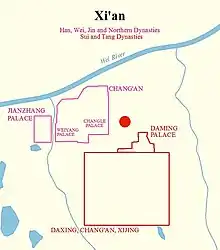
.jpg.webp) Epitaph from the tomb of Li Dan.
Epitaph from the tomb of Li Dan.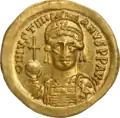 Type of the gold coin of Justinian I discovered in the tomb.[5]
Type of the gold coin of Justinian I discovered in the tomb.[5]
 Side panel decorated with a white dragon.
Side panel decorated with a white dragon.
Similar coffins
.jpg.webp) Sarcophagus of Li He, a Northern Zhou general, of similar design (李和墓, 505—582).[7]
Sarcophagus of Li He, a Northern Zhou general, of similar design (李和墓, 505—582).[7]_-_Coffin.jpg.webp) Sarcophagus of Emperor Xuanwu (483-515 CE).
Sarcophagus of Emperor Xuanwu (483-515 CE).
See also
- Sogdian tombs in China
References
- Li, Yusheng (2016). "STUDY OF TOMBS OF HU PEOPLE IN LATE 6TH CENTURY NORTHERN CHINA". Newsletter di Archeologia CISA. 7: 94–96.
- Original text of the epitaph: 周故邯州刺史,李君墓志铭,/君讳诞,字陁娑,赵国平棘人,其/先伯阳之后。祖冯何,世为民酋,/考傍期,不颓宗基。君禀玄妙气,/正光中自罽宾归阙,太祖以/君婆罗门种,屡蒙赏。君春秋五/十九,保定四季歲次甲申四月/九日薨萬季里宅 皇帝授君/邯州刺史,其年閏月葬中鄉里/长子槃提恐山移谷徙声谧无/闻敬镌玄石以传不朽。
- "Tomb of Li Dan, Chang'an, the Byzantine gold coin". Dla.library.upenn.edu.
- Li, Yusheng (2016). "STUDY OF TOMBS OF HU PEOPLE IN LATE 6TH CENTURY NORTHERN CHINA". Newsletter di Archeologia. 7: 115, Fig.2.
- "Tomb of Li Dan, Chang'an, the Byzantine gold coin". Dla.library.upenn.edu.
- Li, Yusheng (2016). "STUDY OF TOMBS OF HU PEOPLE IN LATE 6TH CENTURY NORTHERN CHINA". Newsletter di Archeologia CISA. 7: 94–96, 118 Fig.7.
- RIBOUD, PÉNÉLOPE (2007). "Bird-Priests in Central Asian Tombs of 6th-Century China and Their Significance in the Funerary Realm". Bulletin of the Asia Institute. 21: 17. ISSN 0890-4464. JSTOR 24049360.
